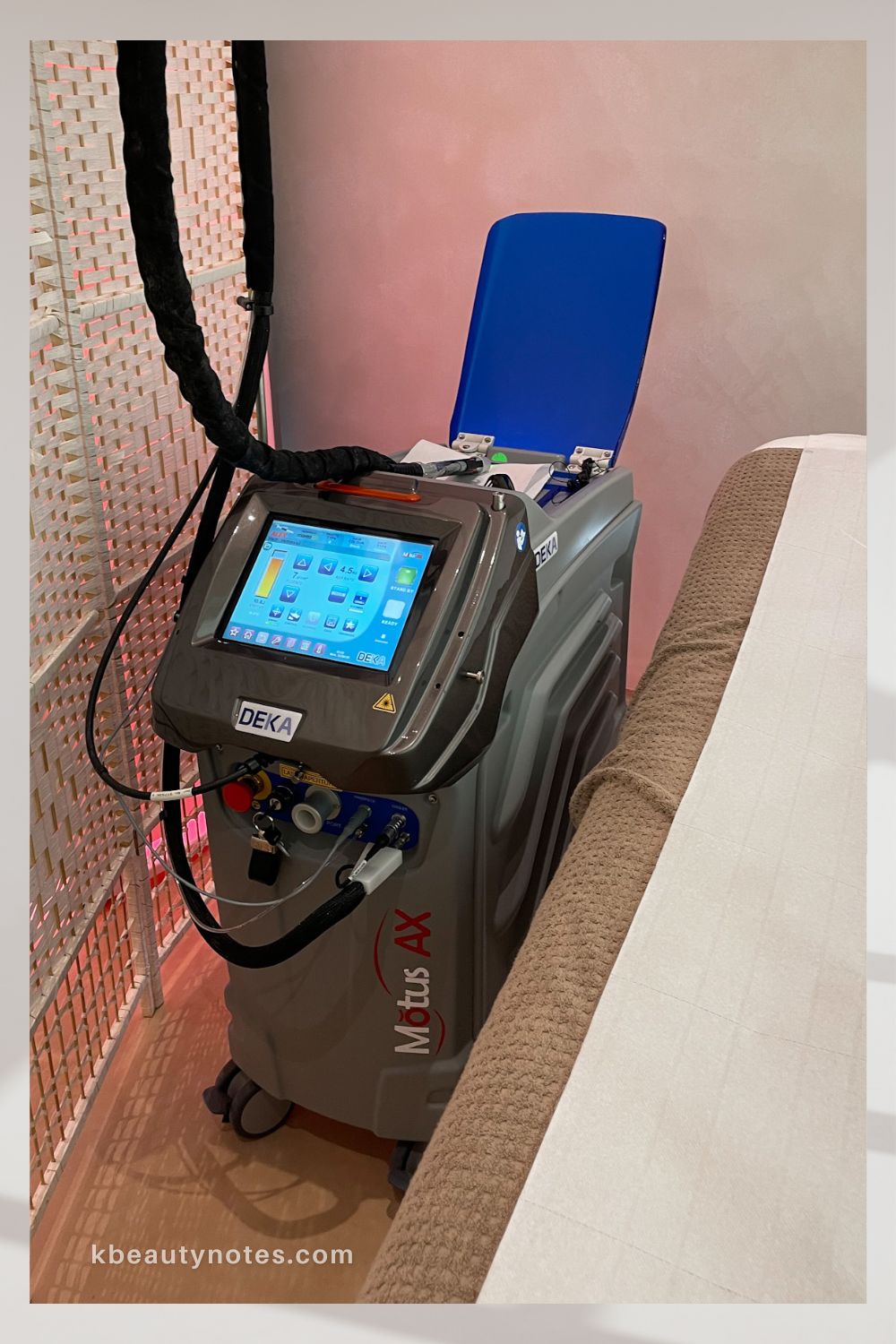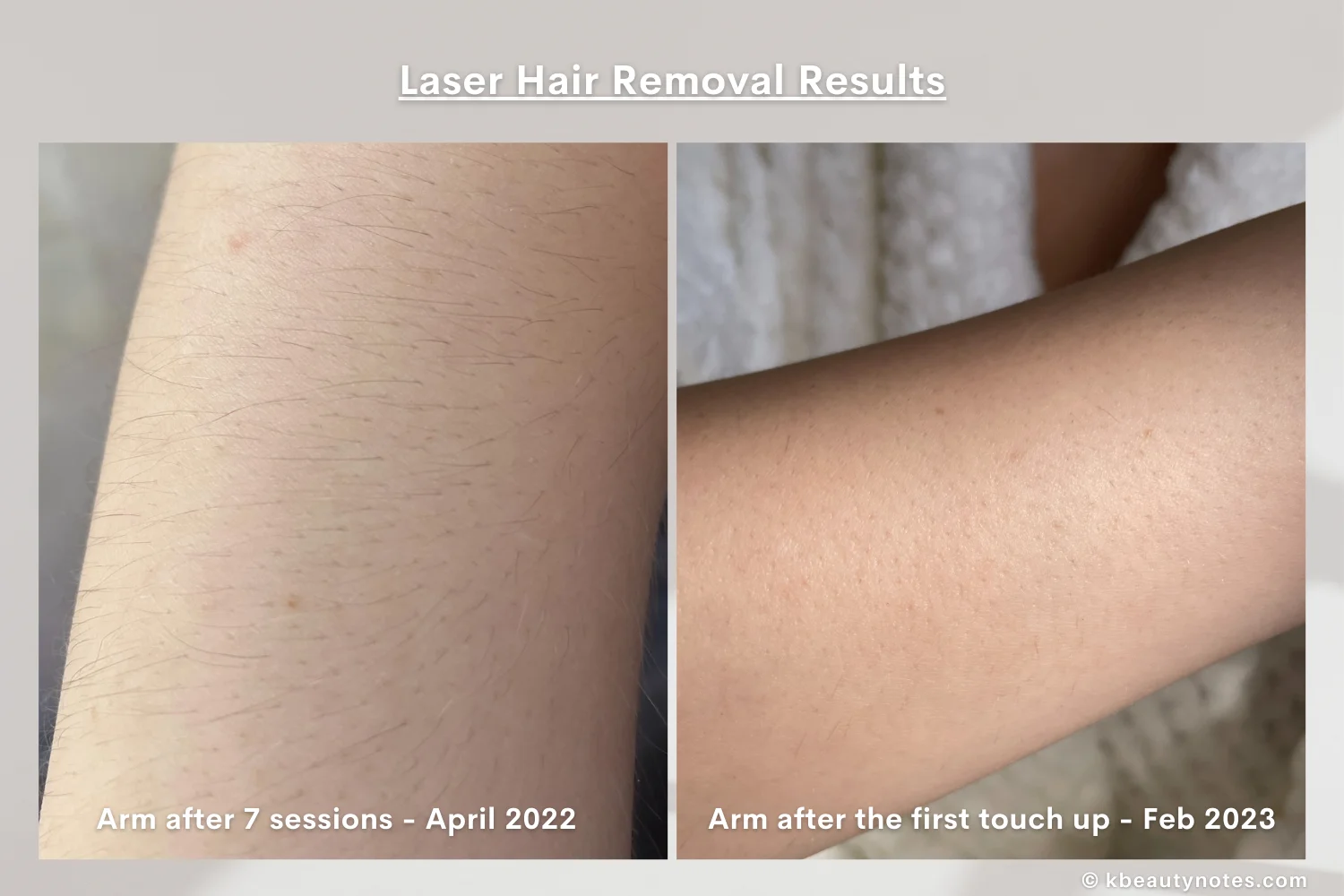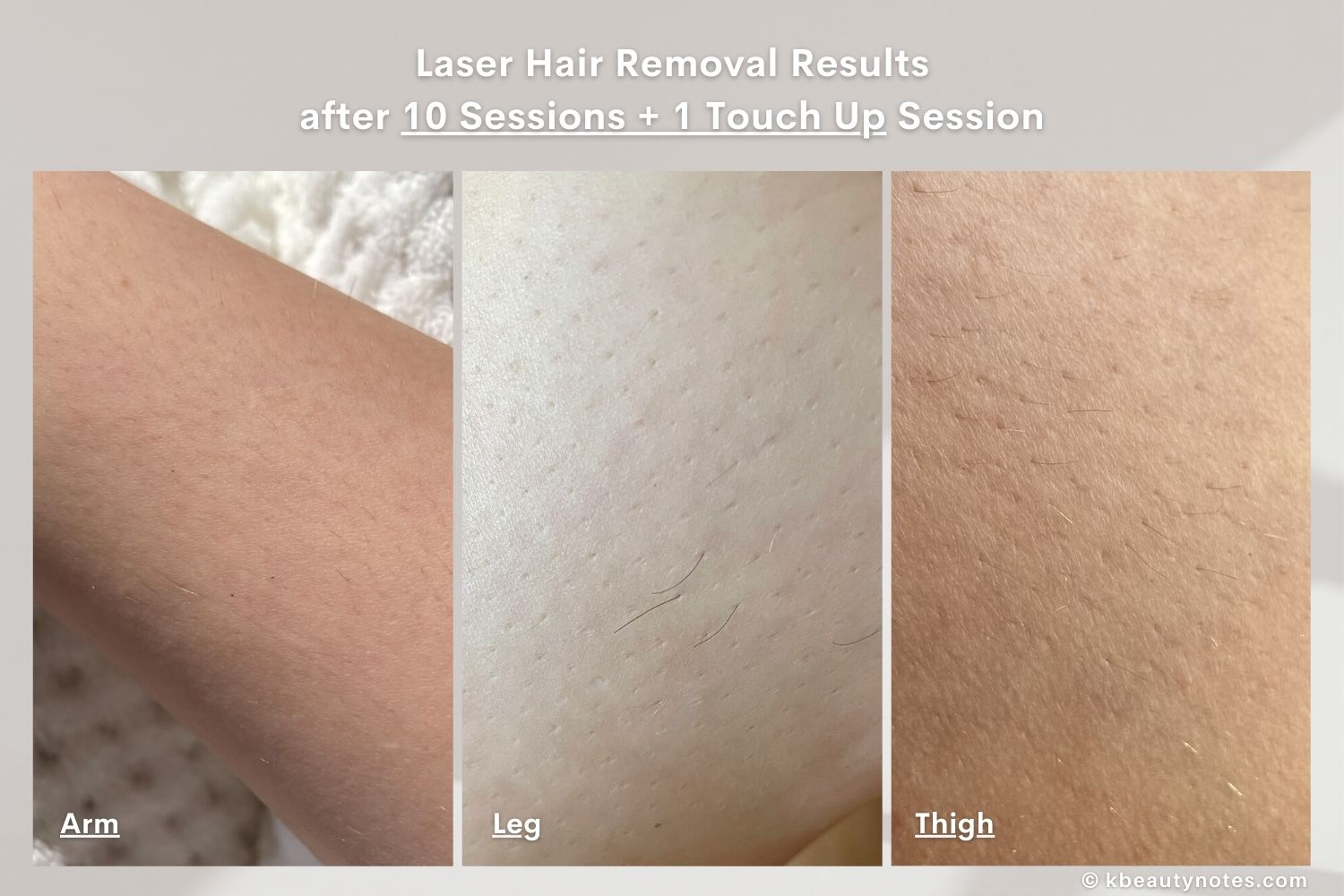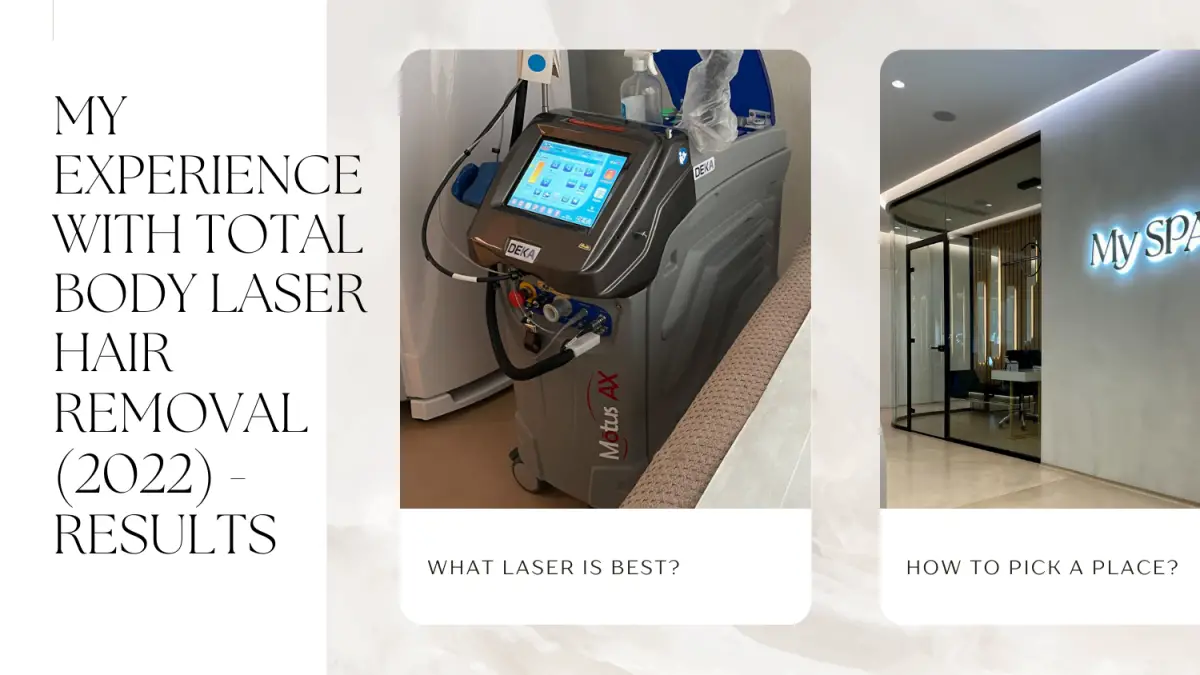Are you thinking of getting laser hair removal to permanently get rid of unwanted hair but not sure what to expect? Is it worth the money? How do you pick the right place? After considering it for a long time, I finally took the plunge and started my laser sessions in mid-2021. In this post, I will share my experience with total body laser hair removal, some tips, and what I’ve learned along the way.
Which hair removal laser is the best?
Your practitioner will determine the best laser based on your skin and hair type.
Laser works by penetrating the hair follicle, which is absorbed by the pigment in the hair shaft. This process generates heat and damages the follicle to inhibit hair growth.
I have light skin, which falls in the Fitzpatrick (considers skin coloring and response to UV) I-III scale, and my hair in areas like armpits, bikini, and below the knees is dark and coarse. Two different laser machines were used on me. I had the first six sessions done with Trio Max Pro Alexandrite and four sessions plus one touch-up session with Deka MOTUS AX – both being “in-motion” pain-free Alexandrite (755nm) lasers.
This type of machine allows for repeated passages on the treated areas with low-power pulses. They induce gradual heating of the hair to avoid pain and side effects, especially for total body laser hair removal, unlike the traditional aggressive alexandrite, which can be uncomfortable because they heat the hair follicle in one single shot.

They changed my laser after the 6 sessions because I was not seeing significant improvement with the first one. Both had a cooled tip and integrated cooling system to reduce discomfort.
It is said that Deka MOTUS AX can be used across all skin phototypes, both light and dark skin, by simply modifying the machine settings. I know that people with tanned skin have used it with no problem. However, settling for Nd: YAG (1064 nm) or Diode (810nm) lasers for hair removal, if you have darker skin (type IV and up), could be a better choice so you don’t risk any potential side effects. There are Diode lasers with “pain-free” modes, although not all. I would definitely consult this with the specialist to ensure you get the best option!
Why did I decide to have laser hair removal done?
After trying all types of hair removal methods for years, I decided to go for total body laser hair removal for several reasons. First, I have a combination of very dark coarse hair (mainly legs from the knee down, armpits, bikini) and sensitive skin on my body (if picked).
The following hair removal methods had some drawbacks for me:
Epilating was extremely painful the first few times, so I could not use it on the bikini area. The hair took about a week to grow back, but on those first few days, every follicle was inflamed, and I got ingrown hairs (despite exfoliating). My armpits were the only place I could use an epilator with no issue after building tolerance.
Waxing was not as painful, but for me worked only when the hair was at a certain length because it was too thick for the wax to grab onto. So, I had to let it grow out a bit before waxing. This, too, made my hair follicles inflamed and resulted in ingrown hairs. Another downside is that it got messy for me. It worked best on my arms, though.
Shaving is the fastest and more convenient, but the hair grows back quickly. And because of this, the bikini area became a nightmare for me. The hair pocking my skin for a whole week made walking very uncomfortable. Also, because the hair on my legs was thick, I experienced a lot of irritation.
For me, it was so difficult even to wear a dress or go to the beach without my legs and bikini area feeling itchy and looking like chicken skin.
This truly affected my everyday life, and that’s why I decided to go for full body laser hair removal instead.
Things to do before starting laser hair removal
The first thing you should do before starting the sessions is to have a blood test done and check your hormone levels. If you have a lot of hair growth due to hormones, you won’t get the desired results, and your hair will return. Laser hair removal is an expensive procedure, and you want to increase the chances of success as much as possible. Moreover, consult with a medical professional about what you should consider (like medications you’re taking or any pathologies, etc.).
Your specialist should advise you to do all these things. Unfortunately, I wasn’t asked any questions, which showed a lack of professionalism on the part of the clinic I went to.

How to prepare before a laser hair removal session?
You should NOT remove your hair by plucking, epilating, threading, or waxing starting six weeks before treatment and until you finish all your laser sessions, including touch-ups. This is because the hair follicle needs to be present in order to be targeted by the laser! Otherwise, treatment will render ineffective. Shaving is your only option.
You should not shave or use lotions after your session to avoid irritation.
Avoid sun exposure. This is important because UV rays may irritate and cause skin discoloration. I would avoid prolonged sun exposure ten days before and two weeks after treatment. Also, I applied sunscreen on the exposed areas daily if I had to go out. I went to the beach one month after my last session in 2022.
I was advised to shave 24 hours before treatment. This will depend on the machine used, though. I’ve had two Diode laser sessions done in 2019, and the hair needed to be about 2mm above the skin surface. They kept postponing my sessions because the hair was not in the required length, so I stopped going altogether. But I found a way later!
The truth is that hair grows at different speeds in every area. I tried to observe my hair growth for some time, and I noticed that the hair on my bikini area grows the fastest. Then the hair below the knee, and then thighs, armpits, and arms.
TIP! There are two things you can do in this case:
- Shave each part on separate days according to your hair growth rate.
- Use an electric razor to get all the hair at the same length.
Important! Make sure to shave well. I had some long hairs in the bikini area a couple of times, and it was very painful when the laser hit them.
Does laser hair removal hurt?
The pain was one of the things that made me hesitate to get laser hair removal done for some time. No matter how comfortable or painless it may seem in advertisements, it always looked painful to me. But now that I’ve experienced it, to answer this question accurately, there are three main things to consider:
- The laser machine that will be used and its settings.
- The pain threshold varies by person.
- Different body areas will have different pain tolerance.
1. Traditional laser vs. “Pain-Free” or “In-Motion” laser.
Lasers have come a long way, and the newer technologies aim to make them as comfortable as possible while still being effective. Most have a built-in cooling handpiece, like the ones used on me. These are much more comfortable, especially for those with thicker, darker hair like me.
Even some professionals recommend starting with this type of laser first for those with darker hair. After some treatments, when the hair has been significantly reduced, they can change to a traditional laser to target the stubborn hair that’s left.
2. Pain tolerance varies from one person to another.
Unless you are super sensitive, you should be OK with a “pain-free” laser. Also, you can ask the practitioner to test it on a small area. So before fully committing, you can have it tested on a few areas and see if it’s tolerable.
With each session, the settings will be increased up to a point, but for me, it felt the same every time.
3. The sensation is different on different body parts.
Based on my experience, it was pretty painless in certain areas. I didn’t feel it at all on my arms. Legs were fine too. But I felt it most on my armpits, bikini, and perianal area. The sensation is exactly like being snapped with a rubber band. Since the practitioner will be moving the handpiece around, you won’t feel it constantly, though.
This depends on the hair length too. The longer the hair, the more you will feel it. But since the hair needed to be shaved close to the skin surface, it wasn’t as uncomfortable as you’d imagine. Plus, you get used to it after a couple of times.
One thing I do know for sure, though! I would not be able to have laser hair removal on the bikini area with a traditional alexandrite laser.
Is laser hair removal permanent?
Will my hair grow again after laser hair removal? Laser hair removal is often advertised as a permanent hair removal method, but the truth is that it only reduces the number of unwanted hairs and doesn’t get rid of them completely. However, you should be able to maintain the results with touch-up sessions.
The only permanent hair removal treatment is, in fact, electrolysis because it completely destroys the hair follicle so no hair can grow again. But, it’s very time-consuming for large areas and can get very expensive.
Laser hair removal cost
How much is laser hair removal? This will depend on your country, clinic, and laser device. In some places, if you pre-pay the sessions, there can be discounts, which is what I did.
I had mine done at a SPA clinic, which cost as much as one month of the average wage in my country – 450 euros. And this was one of the affordable options. Every touch-up costs 100 euros. There were some things I liked and didn’t like regarding the place I chose.
Before you pick a place to have it done, please carefully consider:
1. Know who will conduct the procedure, and make sure they are a licensed professional.
The staff where I went did receive some training but had limited knowledge and couldn’t answer some of my questions. This made me feel uncomfortable and frustrated in some instances.
Also, they changed the person every time I had the laser done. I didn’t like this because they couldn’t know how my sessions were progressing.
So, make sure there’s the same practicioner that will follow you from start to finish!
2. The laser machine that will be used and why. Avoid clinics that use outdated machines.
3. Testimonials. – Very important! Check for customer reviews on their pages and Google. You can find many details about the clinic in their responses.
4. Booking process. The clinic I went to was open until 9 PM, so that was a good thing since you could go after finishing work. You could also call them and quickly reschedule your appointment. What I didn’t like was that every time I went, I had to wait at least 30-40 minutes before treatment.
How many hair removal sessions do you need and how often should you get them?
I bought a package of 8 total sessions (plus two touch-ups every six months). I had to get one session every 40 days. The new laser had to be done once every 30 days. This was the default for everyone, and the clinic didn’t offer me any customization based on my individual needs (because not everyone has the same hair type or growth cycle).
The number of sessions and appointments will depend on the laser used, but your hair growth rate should also be considered. So, make sure to ask your practitioner. They should advise you on the number of treatments based on the area, hair density, and color. You may need to go at different intervals for different body areas too.
All in all, I wasn’t offered any individualized schedule, which was another thing I didn’t like about the clinic.
Total Body Laser Hair Removal Results – Before and After
My total body hair removal package included these areas: Full arms and fingers, armpits (axilla), the vertical hair strip starting from the belly button, full Brazilian hair removal (bikini and perianal area), buttocks, the lower part of my back, thighs, legs, and toes.
I mentioned in the beginning that after some sessions, I wasn’t getting any significant results or what I was expecting, so I ended up doing ten consecutive sessions instead. And for dark and coarse hair like mine, it may take up to 12 full sessions!
Advice: Many clinics advertise that you will be hair-free in as few as 4-6 sessions! And that can be true for many, especially if all conditions are met, such as no hormonal problems, the suitable laser machine, and the practitioner is knowledgeable and knows what they’re doing.
However, that’s not always true, and to help you avoid getting discouraged or disappointed, keep these two things in mind:
- Expect to go through more sessions than what’s advertised!
- Have a larger budget available than you initially thought you’d spend, just in case you’ll have to go through more treatments.
My experience with Total Body Laser Hair Removal
I wish I had taken more pictures before starting and between appointments, but I will try to explain as much as possible.
1-2 weeks after each appointment, around 30% of the hair in each area fell out except for one time which was the staff’s fault, and was replaced with a free session.
You should see your hair falling, but again, don’t pluck it. You can also use an exfoliating loofah to loosen the hair, and it gets out very easily.
However, after 30 days from the session, each time, I also had a lot of re-growth, which was especially noticeable in the bikini area where a good 70-80% of hair was coming back. That’s why I think more frequent treatments were needed but the clinic didn’t provide it.
I was getting results but not the ones I was expecting. You can see in the picture below that even after eight sessions, some parts on my legs (fortunately just a few)still had super dark coarse hair re-growing. In the next session, they were targeted better and fell out, though.

What are the results on different body areas:
After doing the full ten sessions plus one touch-up, I am way more satisfied with the results on my legs. Even before my touch-up, there was a good amount of re-growth (around 40%), but the hair was light and soft. I can shave the area very easily now, and it doesn’t become irritated or inflamed.
The armpits are where I see the best results! There’s almost no growth there. Only a few hairs that are undetectable.
The hair on my arms, although dense, it was never coarse. There is a noticeable change for sure, but there’s a lot of re-growth of fine hair too. After all these treatments, I was expecting a bit more. My satisfaction level, I’d say, would be 70%.

The same goes for my thighs but a bit better. Hair is similar to the hair on my arms. There is some regrowth, but it remains soft, and it’s only noticeable up close.
The treatment wasn’t that effective on my lower back and buttocks, where the hair is thin and without noticeable pigment. And this is understandable since the laser targets the pigment in the hair, so there wasn’t much to work on.
Now to the bikini part. This area and my legs below the knee were my biggest concerns. And the bikini area has been the most stubborn. I had the most re-growth here. Even before the 10th session, around 70%-80% of the hair was still present. The hair does feel a bit softer than it was, but still. After so many sessions, the results could be more optimal.
Fortunately, I didn’t get blistering, hyperpigmentation, or irritation from the laser. My skin would be a tad bit red for a few minutes and nothing else.

Does laser hair removal work? Is it worth it?
Well, yes, it does work. Considering how difficult it was for me to remove my hair, overall, it was worth going for the full-body laser hair removal! And I’m glad I did it. It saves me a lot of time and effort, too! I just wish I was a bit more informed before starting.
Does it meet my expectations, though? Is it as good as I was expecting it? Yes and no. In some areas, I’m satisfied, especially my legs (you can see the second picture). They feel smooth, and I don’t get inflamed follicles anymore. For other areas, I expected more.
For my next touch-up session after six months, I am considering changing the clinic to see if there’s a better option out there. I will update this post for sure.
Did you find this post on Body Laser Hair Removal helpful? Let me know your thoughts in the comments.
Disclaimer: This post does not provide medical advice. It is intended for informational purposes only.
Related posts
Follow blog via Email
Get the latest posts from this blog delivered to your inbox!
About Me
Hi and welcome to Kbeauty Notes! :)
I’m Ledia and I’m very passionate about everything skincare. I created this blog to share my thoughts and experience with many amazing and not so great products out there, hoping to help you make better decisions regarding your skin.
I’m very happy to bring you on this journey with me and I hope you enjoy it! <3
My Skin Type: Oily, acne prone, dehydrated, a little sensitive, large pores.
Skincare Concerns: hydration, pore care, anti-ageing, PIE (acne marks), brightening.
Contact: kbeautynotes@gmail.com



